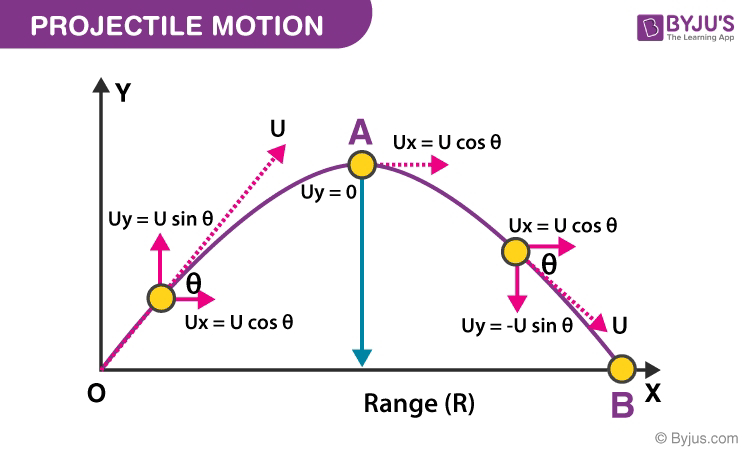Table of Content
1) Definition of Projectile Motion
2) Real life examples of Projectile Motion.
3) Words related to projectile motion.
4) Weekly assignment and classwork.
1) Projectile Motion:
Projectile motion is a type of motion in which an object is thrown into the air and moves along a curved path under the influence of gravity, without any additional propulsion. It can be described as the combination of horizontal motion with constant velocity and vertical motion with constant acceleration due to gravity. The path of a projectile is typically parabolic, and key factors affecting its motion include the initial velocity, launch angle, and gravitational force.
2) Real life examples of Projectile Motion:
Projectile motion is commonly observed in various real-life situations. Here are some examples:
Throwing a Ball: When you throw a ball, it follows a parabolic path in the air due to the combination of its horizontal motion (constant velocity) and vertical motion (affected by gravity).
Jumping Divers: In diving competitions, divers jump from springboards or platforms. Their motion as they dive into the water follows a projectile trajectory.
Fireworks: Fireworks explode and launch into the sky, displaying beautiful patterns as they follow a projectile path before bursting into colorful displays.
Baseball Pitching: When a pitcher throws a baseball, it follows a curved path on its way to the batter, exhibiting projectile motion.
Golf Shots: In golf, when a player hits a golf ball, it follows a parabolic path as it travels through the air before landing on the fairway or the green.
Projectiles Fired from Weapons: Bullets, missiles, and artillery shells follow projectile motion once they are fired or launched.
Water Balloon Toss: During a water balloon toss, the water balloon follows a projectile path as it travels through the air from one person to another.
Ski Jumping: In ski jumping, athletes slide down a ramp and take off into the air, following a projectile path before landing.
These examples demonstrate how the principles of projectile motion can be observed in various everyday scenarios and activities.
Projectile: An object that is thrown or launched into the air and is subject to the force of gravity. Projectiles move along a curved path under the influence of gravity.
Trajectory: The path that a projectile follows through space. It is typically parabolic in shape.
Initial Velocity: The velocity of the projectile at the moment it is launched or thrown. It has both magnitude (speed) and direction.
Launch Angle: The angle at which a projectile is initially launched or projected with respect to the horizontal. This angle plays a crucial role in determining the shape of the trajectory.
Horizontal Motion: The motion of a projectile in the horizontal direction, which remains constant if air resistance is neglected.
Vertical Motion: The motion of a projectile in the vertical direction, influenced by gravity. The object undergoes constant acceleration due to gravity (usually -9.8 m/s² on Earth).
Range: The horizontal distance traveled by a projectile from its initial point of launch to its landing point.
Maximum Height: The highest point reached by a projectile in its trajectory. It occurs when the vertical velocity becomes zero momentarily.
Time of Flight: The total time it takes for a projectile to travel from the launch point to the landing point.
Projectile Equation: A set of equations used to describe the motion of a projectile, including equations for calculating the range, maximum height, and time of flight.
Acceleration due to Gravity: The constant downward acceleration that all objects experience due to gravity. On Earth, it is approximately 9.8 m/s².
Understanding these terms is essential for analyzing and predicting the motion of projectiles in various real-world situations.
Follow the WhatsApp group to understand more.
Click Quiz to do your assignment.
Weekly Assignment:
Define the following:
A)Trajectory
B) Projectile
C) Range
D)Launch Angle
Solve this:
A rock is thrown horizontally off a cliff 100.0m
high with a velocity of 15.0 m/s. (a) Define the origin of the coordinate system. (b) Which equation describes the horizontal motion? (c) Which equations describe the vertical motion? (d) What is the rock’s velocity at the point of impact?



